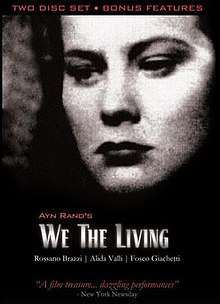
We the Living is the debut novel of the Russian American novelist Ayn Rand. It is a story of life in post-revolutionary Russia and was Rand's first statement against communism. Rand observes in the foreword that We the Living was the closest she would ever come to writing an autobiography. Rand finished writing the novel in 1934, but it was rejected by several publishers before being released by Macmillan Publishing in 1936. It has since sold more than three million copies.

Rossano Brazzi was an Italian actor. He moved to Hollywood in 1948 and was propelled to international fame with his role in the English-language film Three Coins in the Fountain (1954), followed by the leading male role in David Lean's Summertime (1955), opposite Katharine Hepburn. In 1958, he played the lead as Frenchman Emile De Becque in the Rodgers and Hammerstein musical South Pacific. His other notable English-language films include The Barefoot Contessa (1954), The Story of Esther Costello (1957), opposite Joan Crawford, Count Your Blessings (1959), Light in the Piazza (1962), and The Italian Job (1969).
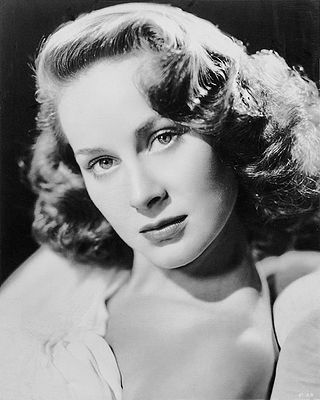
Alida Maria Laura, Freiin Altenburger von Marckenstein-Frauenberg, better known by her stage name Alida Valli, was an Italian actress who appeared in more than 100 films in a 70-year career, spanning from the 1930s to the early 2000s. She was one of the biggest stars of Italian film during the Fascist era, once being coined "the most beautiful woman in the world" by Benito Mussolini, but managed to find continued international success post-World War II. According to Frédéric Mitterrand, Valli was the only actress in Europe to equal Marlene Dietrich or Greta Garbo.

For the New Intellectual: The Philosophy of Ayn Rand is a 1961 work by the philosopher Ayn Rand. It is her first long non-fiction book. Much of the material consists of excerpts from Rand's novels, supplemented by a long title essay that focuses on the history of philosophy.

Goffredo Alessandrini was an Italian scriptwriter and film director. He also acted, edited, and produced some films.

Amedeo Nazzari was an Italian actor. Nazzari was one of the leading figures of Italian classic cinema, often considered a local variant of the Australian–American star Errol Flynn. Although he emerged as a star during the Fascist era, Nazzari's popularity continued well into the post-war years.

Fosco Giachetti was an Italian actor.

Erika Holzer was an American novelist and essayist who was a close associate of Ayn Rand. Her novel Eye for an Eye was the basis for a major motion picture of the same name. She also co-authored two nonfiction books with her husband, professor of law Henry Mark "Hank" Holzer.

Light in the Darkness is a 1941 Italian drama film directed by Mario Mattoli and starring Fosco Giachetti, Alida Valli and Clara Calamai. The film's sets were designed by the art director Ottavio Scotti. It was shot at the Palatino Studios in Rome.
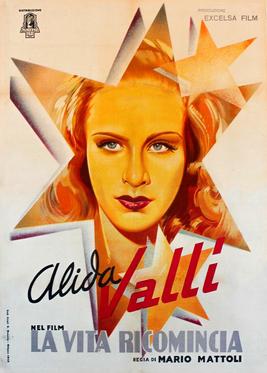
Life Begins Anew is a 1945 Italian melodrama film directed by Mario Mattoli and starring Alida Valli, Fosco Giachetti and Eduardo De Filippo. It was the second most popular Italian film during 1945-46 after Roberto Rossellini's Rome, Open City.
We the Living is a 1936 novel by Ayn Rand.
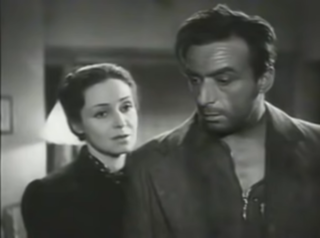
Bengasi is a 1942 Italian war film directed by Augusto Genina and starring Fosco Giachetti, Maria von Tasnady and Amedeo Nazzari. The film was shot at Cinecittà in Rome. The film was a propaganda work, designed to support the Fascist regime of Benito Mussolini. It portrays Allied atrocities in "Bengasi Italiana", such as the murder of a peasant by a group of drunken Australian soldiers.
The "10th" annual (void) Venice International Film Festival was held from 30 August to 5 September 1942. The events were hosted at places far away from the Lido and very few countries participated due to World War II and directors that were members of the Rome-Berlin axis. Additionally, a strong fascist political meddling from the Italian fascist government under Benito Mussolini had led to Italy experiencing a period of cultural depression oppressed by fascist propaganda. It is the last edition before the suspension for the Second World War.

Duncan Scott is a film and television writer, director, and producer. Scott was one of the screenwriters of Atlas Shrugged: Part II and Atlas Shrugged: Part III. Early in his career, he became involved in the restoration of the 1942 film We the Living, a project that he continued to be involved in over the next several decades. Scott also directed and produced for television, winning several Emmy and Telly Awards, as well as being nominated for a Peabody Award.

Girl of the Golden West is a 1942 Italian western film directed by Carl Koch and starring Michel Simon, Isa Pola and Rossano Brazzi. It is based on the 1936 novel, La Dame de l'Ouest, by Pierre Benoit. It was made at the Scalera Studios in Rome, and on location in Lazio countryside. The film's title alludes to the opera The Girl of the Golden West by Giacomo Puccini, but is not an adaptation of it. It was one of only a handful of Westerns to be made during the silent and Fascist eras, in a genre in which Italy later became famous.
The Last Enemy is a 1938 Italian drama film directed by Umberto Barbaro and starring Fosco Giachetti, María Denis and Guglielmo Sinaz.

Blood Wedding is a 1941 Italian drama film directed by Goffredo Alessandrini and starring Beatrice Mancini, Fosco Giachetti and Luisa Ferida. It is set in 19th century South America, and features an arranged marriage. The film is based on the novel Immacolata by Lina Pietravalle.

The Secret Lover is a 1941 Italian drama film directed by Carmine Gallone and starring Alida Valli, Fosco Giachetti and Vivi Gioi. It was made at Cinecittà in Rome.
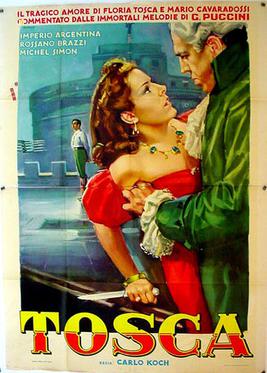
Tosca is a 1941 Italian historical drama film directed by Carl Koch and starring Imperio Argentina, Michel Simon and Rossano Brazzi. It is an adaptation of Victorien Sardou's play La Tosca and its subsequent opera version, Tosca, composed by Giacomo Puccini to a libretto by Luigi Illica and Giuseppe Giacosa. It was released in the United States as The Story of Tosca.

Minerva Film was an Italian film production and distribution company active between 1912 and 1956. It should not be confused with a similarly-named Danish production house.


